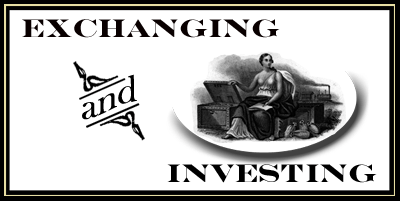
Rising and established entrepreneurs benefited from the nation's new financial institutions. Central banks, stock markets, bills of exchange, and paper currency extended men's capital and facilitated more expansive commercial transactions. The nature of these transactions spurred a shift away from face-to-face business toward an increased reliance on distant and anonymous relations. The very business forms created to promote active investment and commerce, however, remained unstable during the early Republic. Stock markets crashed, banks failed, debtors went bankrupt, and dupes accepted counterfeit currency.
Bank of Germantown. Reproduction of photograph by John Moran. Philadelphia, 1868.
The closing of the First Bank of the United States, plus the War of 1812, which left the country bereft of circulating specie, sparked a wave of new state banking charters. By 1815 the United States had some 210 chartered banks, or one for every 30,000 free people. The Bank of Germantown was one of 41 new banks chartered in Pennsylvania alone after passage of the state's Banking Act in 1814. Located in the house of noted antiquarian John Fanning Watson, who also served as its first Cashier, the bank served the needs of those who lived a distance from the financial services found in port cities. That many of the bank's first subscribers were women indicates that they may have overseen the household while their husbands were away or carried on family accounts as widows.
Bank of the United States in Third Street, Philadelphia. William Birch & Son. Hand-colored engraving. Philadelphia, 1799.
The First Bank of the United States began operation in 1791 and was jointly funded by private and government monies. Then Secretary of the Treasury Alexander Hamilton modeled it after the Bank of England as an institution meant to spur private commerce and support government funding of debts. The Bank was the nation's largest business enterprise of the time, capitalized at $10 million. Its shares, at $400 each, sold out within hours of being offered to the public on the 4th of July.
By 1805 the Bank had seven branches which circulated an acceptable form of paper currency throughout the country, although it was used mainly for wholesale rather than retail purchases. Critics of the Bank feared that national finances would be controlled by only the very wealthy, who owned 80% of the shares, while supporters felt it was important to have a bank that allowed the federal government ready access to large reserves of deposits. Thomas Jefferson, who had argued that the Bank was unconstitutional, divested the remaining 2,200 shares of government stock in 1802. Congress allowed the Bank's charter to expire in 1811.
The building itself, attributed to Samuel Blodget, Jr., a merchant, economist, and amateur architect, was constructed from 1795-1797. Incorporating a neo-Roman portico upheld by Corinthian columns, it was meant to convey the solidity and stability of republican ideals.
The Times. Edward Clay. Lithograph. New York, copyright, 1837.
The Panic of 1837 to 1842 was the most severe financial crisis in antebellum America. What began as a decade flush with indications of economic optimism - major internal improvements, westward expansion, the opening of local banks, wide extension of credit, and enthusiastic consumption - ended in hard times.
A confluence of circumstances burst the speculative bubbles of the early republic. A decline in the British economy forced hardship on American cotton growers who had been extended generous foreign credit and enjoyed markets for their exports. When British lenders called in their loans, American debtors scurried for money, which the overextended Southern banks could not provide. Additionally, President Jackson's "Specie Circular," issued in 1836 and intended to curb western land speculation, required purchases to be paid for in specie rather than paper currency, undermining faith in the soundness of western banks and causing a run on their specie. At the same time, the charter of the Second Bank of the United States expired, and Jackson, directly undermining economic faith enjoyed from having a central bank run by the government, placed reserves of specie in "pet" banks.
This political cartoon depicts the consequences of the Panic. Jackson's financial vision is depicted as "Glory," and the disembodied top hat and spectacles illuminate the lives below. The Custom House, mandating that "All Bonds must be paid in Specie," remains empty. Next door, a mob crowds the Mechanics Bank, representing small depositors who relied on local banks. Shylock Graspall and Peter Pillage, pawnbroker and attorney, continue to prosper, while most of those appearing in the foreground do not. A mother and her baby lay prostrate on a straw mat as a drunkard nearly tramples them. Another mother and her child beg for money from a bondsman, and a sailor and two artisans remain unhappily idle. The balloon of the "Safety Fund" (banks' "rainy day" reserves of specie) has burst in the air, and its passengers fall toward the almshouse and Bridewell debtors prison, below.
Website Site Design by Nicole H. Scalessa, IT Manager & Reference Librarian. Send Questions or Comments to nscalessa@librarycompany.org. All Rights Reserved.